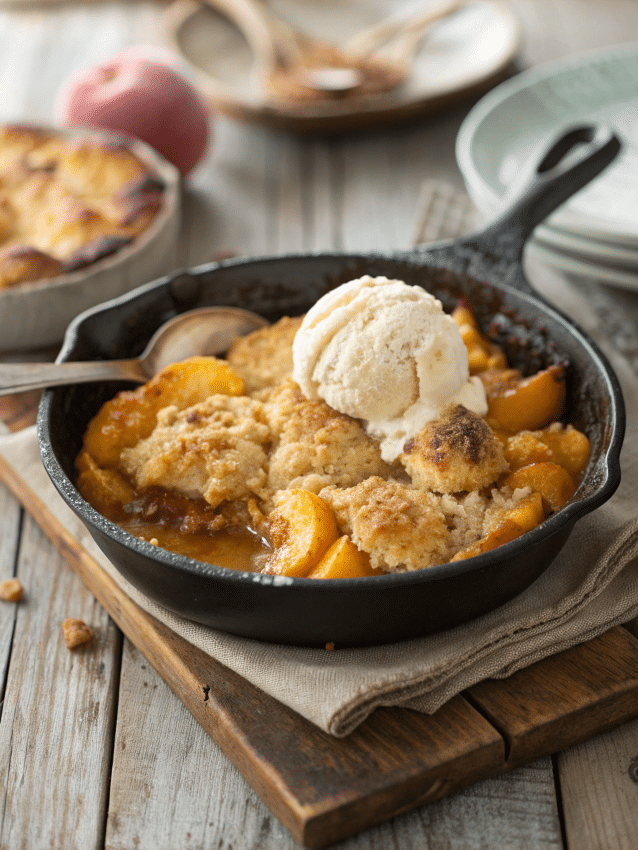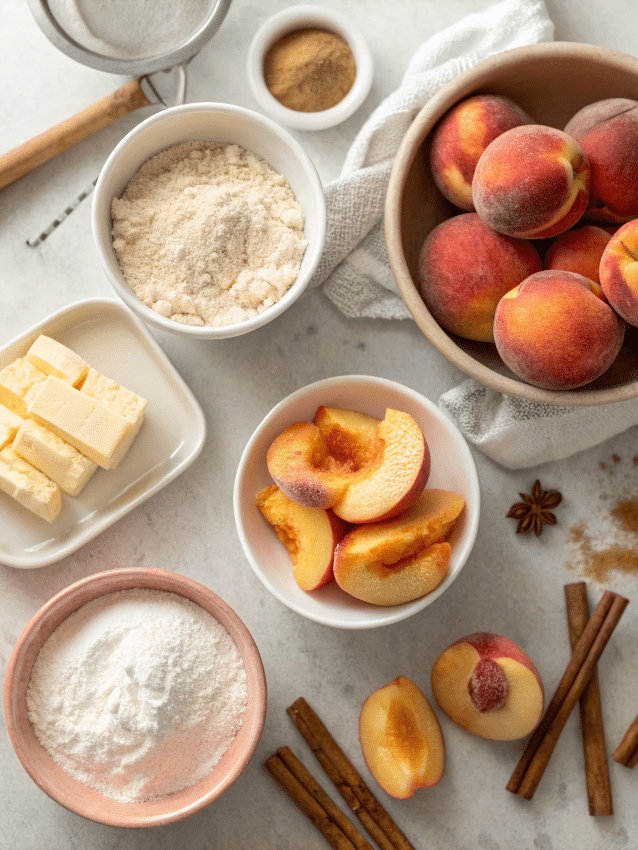
Peach cobbler recipe, the very words take me back to a summer afternoon in Georgia, where the smell of baked peaches drifted out of a small-town diner. The cobbler that day came bubbling to the table with golden edges and a soft, cake-like middle. One bite, and I was hooked for life. Back home in North Carolina, I tried recreating that same magic in my own kitchen. The first attempt was far from perfect, but that’s the charm of cobbler, it forgives your mistakes and still delivers something comforting and delicious.
Cooking became my way of finding balance, and peach cobbler quickly became a staple on my table. I didn’t need a culinary degree or fancy tools to make it work, just the same everyday ingredients you’d find in recipes like Paula Deen’s pound cake. This cobbler, like the Boston Market sweet potato casserole that always pops up at family gatherings, is more than food, it’s tradition, memory, and comfort baked into one dish.
The best part is that this peach cobbler recipe doesn’t lock you into one style. Fresh, frozen, or canned peaches all work beautifully, which means you can bring this dessert to the table any time of year. Whether it’s a casual weeknight or a holiday spread, this cobbler always feels right.
So kick off your shoes, grab a spoon, and get ready to learn everything you need. This peach cobbler recipe is about to become your new go-to dessert for family, friends, and those quiet nights when you just need a little sweetness.
In this Article
Key Takeaways: What You Need to Know
- This peach cobbler recipe is beginner-friendly and uses real ingredients.
- You can use fresh, frozen, or canned peaches, each works great with slight tweaks.
- Learn how to avoid runny cobbler, pick the best peaches, and store it right.
- Answering top FAQs with practical tips from real home cooks.
The Best Peach Cobbler Starts with the Right Fruit
When it comes to making a truly memorable peach cobbler recipe, the peaches you choose make all the difference. You don’t need to overcomplicate things, great cobbler starts with great fruit. Whether you’re working with fresh, frozen, or canned peaches, each option has its strengths.
Fresh, Frozen, or Canned? Here’s What Works Best
Fresh peaches shine in cobbler because they bring out natural sweetness and that irresistible aroma. If you’re lucky enough to find ripe peaches at the market, they’ll deliver the best flavor and texture. But don’t stress if you can’t. Frozen peaches are the next best choice because they’re picked at peak ripeness and hold their flavor well. Just make sure to thaw and drain them before baking. Canned peaches also work, especially when you’re short on time. The trick is to drain them thoroughly to avoid a soupy filling.
For easy swaps, remember this conversion:
- 6–8 medium fresh peaches (about 4 cups) = 2 (16-ounce) cans drained peaches
- 6–8 medium fresh peaches (about 4 cups) = 40 ounces frozen peaches
This flexibility is what makes a peach cobbler recipe so approachable. It doesn’t matter what season you’re in, you can still bake a dessert that feels special. That’s the same reason readers love practical recipes like crock pot chili, which can adapt to what you already have in the pantry.
How to Pick Ripe Peaches Like a Pro
If you’re lucky enough to work with fresh fruit, picking ripe peaches doesn’t have to feel intimidating. Look for peaches with a golden hue near the stem, not green. Give the fruit a gentle squeeze, it should yield slightly but not feel mushy. And of course, the best peaches will carry that unmistakable sweet, floral fragrance.
If your peaches aren’t quite ripe, set them stem-side down on the counter at room temperature. Within a couple of days, they’ll soften naturally. And don’t worry if your slices aren’t perfect, the fruit cooks down into syrupy goodness no matter what. It’s the same forgiving quality that makes recipes like garlic butter chicken bites so approachable for everyday cooks.
The bottom line? Choose the peaches that work best for you, and let them carry this dessert. That’s the heart of a peach cobbler recipe: simple ingredients, big rewards.
Peach Cobbler Dough, Crisp or Soft?
A peach cobbler recipe is nothing without the topping. While the fruit brings sweetness, it’s the dough that makes every bite satisfying. Some cooks swear by a biscuit-style topping, others lean toward cake-like batter, and a few go with pie crust. The beauty of cobbler is that there’s no single rule, you get to choose what feels right for your kitchen.
The Real Deal with Cobbler Topping
The classic peach cobbler recipe uses a biscuit-like dough. This topping bakes into golden-brown nuggets that sit over the fruit like little pillows, soaking up the peach syrup while keeping a slightly crisp edge. It’s hearty, rustic, and pairs beautifully with vanilla ice cream.
If you’ve ever wondered what separates a cobbler from a crisp or crumble, here’s the key difference: cobbler relies on dough, while crisps and crumbles use streusel-like toppings. According to Wikipedia, the “cobblestone” look is what gave cobbler its name. That’s why, when following a peach cobbler recipe, the topping is just as important as the fruit itself.
Buttery Biscuit vs. Cake-Like Topper
One of the most common questions people ask is: should my peach cobbler recipe have a biscuit crust or a cake-like topping? The answer is, it depends on what texture you love.
Here’s a quick comparison to help you decide:
| Topping Type | Texture | Best For |
|---|---|---|
| Buttery Biscuit | Crisp edges, tender inside | Traditional peach cobbler recipe |
| Cake Batter | Soft, spongy, slightly sweet | Modern twist on peach cobbler recipe |
| Pie Crust | Flaky, layered texture | Crossover between pie and cobbler |
If you’re unsure, start with the biscuit-style topping, it’s the most authentic and easiest for beginners. Just like in my longhorn parmesan chicken recipe, sometimes sticking to tradition delivers the most flavor.
No matter which path you choose, the peach cobbler recipe works because the topping balances the juicy filling underneath. It’s that contrast, crispy or cakey over syrupy fruit, that makes cobbler unforgettable.

Peach Cobbler Recipe
Ingredients
Equipment
Method
- Preheat oven to 375°F (190°C).
- In a large bowl, toss peaches with sugars, lemon juice, cinnamon, and nutmeg. If using canned or frozen peaches, drain well first.
- Melt butter directly in the baking dish or skillet while the oven preheats.
- In a separate bowl, whisk together flour, baking powder, milk, and salt until smooth.
- Pour batter over the melted butter without stirring.
- Spoon peach mixture evenly over the batter. Do not mix.
- Bake for 40–45 minutes until golden brown and bubbling.
- Let cool slightly before serving warm, ideally with vanilla ice cream.
Nutrition
Notes
Tried this recipe?
Let us know how it was!Preventing a Runny Peach Cobbler Recipe & Getting the Right Texture
One of the biggest challenges when making a peach cobbler recipe is ending up with a runny filling. You pull it out of the oven, the topping looks golden, but underneath is more soup than syrup. The good news? With the right techniques, your peach cobbler recipe can always have that perfect balance of juicy fruit and thick, spoonable sauce.
Why Your Peach Cobbler Recipe Might Turn Out Soupy
There are a few common mistakes that lead to a watery peach cobbler recipe. First, using peaches that are too ripe or too juicy without adjusting the thickener. Second, skipping the step of draining canned or thawed peaches. And finally, not giving the filling enough time in the oven for the liquid to reduce.
If you’ve ever had this happen, you know the frustration, especially when your cobbler looks perfect on the outside. But just like in my gelatin trick recipe, sometimes it comes down to understanding how ingredients behave when heated. The key is balancing the natural juice of the peaches with a thickener that binds it into a sauce.
Thickeners That Work Every Time in a Peach Cobbler Recipe
The secret to a peach cobbler recipe with the right texture is choosing the right thickener. Here’s a quick guide you can trust:
| Thickener | Amount for 4 cups peaches | Texture Result |
|---|---|---|
| Cornstarch | 2–3 tablespoons | Glossy, thick sauce |
| Flour | 3–4 tablespoons | Hearty, slightly cloudy |
| Tapioca | 2 tablespoons | Clear, firm gel |
Cornstarch is the most popular choice, giving your peach cobbler recipe a smooth finish. Flour works well for a rustic, old-fashioned cobbler, while tapioca gives structure that holds up beautifully if you plan to freeze leftovers.
No matter which thickener you use, remember this rule: cook the filling until it bubbles. That’s when the thickener activates, turning excess juice into sauce. If you follow this step, your peach cobbler recipe will always come out spoonable, never runny.
Like with my teriyaki chicken crock pot recipe, timing and balance are everything. Get this part right, and your cobbler topping will sit on a thick, luscious filling that tastes as good as it looks.
The Complete Ingredient Breakdown for a Peach Cobbler Recipe

Every peach cobbler recipe shines because of its ingredients. While the steps matter, it’s what you put into the dish that creates that classic Southern flavor. Choosing the right peaches, sweeteners, and spices is what transforms a simple dessert into the peach cobbler recipe your family asks for again and again.
Ingredient List You Can Rely On
Here’s what you’ll need for a traditional peach cobbler recipe:
- Peaches – 6–8 fresh peaches (about 4 cups), or substitute 2 cans (drained) or 40 ounces frozen
- Sugar – 1 cup granulated sugar, ½ cup brown sugar for depth
- Butter – ½ cup unsalted butter, melted for richness
- Flour – 1 cup all-purpose flour to help structure the topping
- Baking powder – 2 teaspoons to make the dough rise
- Milk – 1 cup, preferably whole milk, for a tender topping
- Spices – 1 teaspoon cinnamon, ½ teaspoon nutmeg
- Lemon juice – 1 tablespoon to brighten the peaches
- Salt – a pinch (try the pink salt recipe if you want a twist)
This balance of fruit, fat, sugar, and spice is what makes a peach cobbler recipe feel complete. It’s simple, but each ingredient plays an important role in achieving the perfect flavor and texture.
Peach Cobbler Recipe: From Scratch or With Mixes
Some cooks prefer making a peach cobbler recipe entirely from scratch, while others reach for shortcuts like cake mix or Bisquick. Both work, but the results are different. A from-scratch peach cobbler recipe gives you control over sweetness, texture, and spice. Meanwhile, using a mix can save time when you’re baking for a crowd or want a quick weeknight dessert.
Here’s a quick comparison:
- Scratch Peach Cobbler Recipe – Balanced flavor, control over sugar, authentic Southern texture
- Cake Mix Peach Cobbler Recipe – Sweeter, lighter, faster prep, great for beginners
- Bisquick Peach Cobbler Recipe – Soft and fluffy topping, with minimal measuring
No matter which path you choose, the heart of the peach cobbler recipe stays the same: juicy peaches baked under a golden topping. And like the Paula Deen pumpkin cheesecake, this dessert proves that the simplest ingredients can create something unforgettable.
The bottom line? A peach cobbler recipe doesn’t demand perfection. What matters most is that every ingredient works together to highlight the fruit. Get the basics right, and you’ll always serve a cobbler that tastes like summer in every spoonful.
How to Bake, Store & Freeze a Peach Cobbler Recipe
Baking a peach cobbler recipe is as comforting as it gets. The scent of butter, cinnamon, and caramelized peaches fills the kitchen, and within an hour you’ve got a dessert that’s rustic yet unforgettable. But baking is just the beginning, knowing how to store and freeze your peach cobbler recipe ensures you can enjoy it for days, or even weeks, to come.
The Best Way to Store a Peach Cobbler Recipe
Once you pull your peach cobbler recipe out of the oven, let it cool completely before covering. If you cover it while hot, the steam will soften the topping, and you’ll lose that golden crispness. The best approach is to store it loosely covered at room temperature for up to two days. For longer storage, move it to the refrigerator, where it will keep for up to four days.
When reheating, don’t microwave the whole dish if you want the topping to stay firm. Instead, warm it in the oven at 350°F for 15–20 minutes. This brings back the texture while keeping the fruit filling bubbly and rich. I use this same method when reheating baked casseroles like the Boston Market sweet potato casserole, and it works beautifully here too.
Can You Freeze a Peach Cobbler Recipe Successfully?
The answer is yes, you can freeze a peach cobbler recipe and still enjoy it later without losing much quality. The trick is to decide whether to freeze it baked or unbaked.
- Freezing baked peach cobbler recipe: Cool it completely, wrap it tightly in plastic wrap, then cover with foil. Freeze for up to three months. To reheat, thaw in the fridge overnight, then warm at 350°F until bubbly.
- Freezing unbaked peach cobbler recipe: Prepare the fruit filling and topping separately. Freeze them in airtight containers, then assemble and bake fresh when ready. This method keeps the topping from getting soggy.
For best results, label your container with the date so you don’t lose track. According to the USDA guide on storing baked goods, frozen desserts are safest when eaten within three months.
I’ve even frozen extra peach filling by itself, much like I freeze leftover broth for my crock pot chili. Later, I just thaw, add a topping, and bake for a quick weeknight dessert. This flexibility is what makes a peach cobbler recipe such a smart dessert, it’s easy to bake ahead, store, and enjoy again.
Cobbler FAQs, Tips & Final Thoughts
Every peach cobbler recipe raises questions, especially if it’s your first time making one. Below, I’ve answered the most common ones, giving you practical advice to help your cobbler turn out perfect every time.
Can you freeze peach cobbler?
Yes, you can freeze a peach cobbler recipe baked or unbaked. For best results, cool it completely before wrapping, or freeze the filling and topping separately to avoid sogginess.
What are the best fresh peaches to bake with?
The best peaches for a peach cobbler recipe are ripe but firm varieties like Freestone peaches. They hold shape while releasing enough juice to create that classic syrupy filling.
How do I keep peach cobbler from being runny?
To keep your peach cobbler recipe thick and spoonable, use cornstarch, flour, or tapioca as thickeners. Also, drain canned or thawed peaches and bake until the filling bubbles.
What is the secret to a juicy peach cobbler?
The secret is balance: ripe peaches, the right amount of sugar, and a touch of lemon juice to brighten flavors. A juicy peach cobbler recipe has plenty of fruit syrup, but never too much liquid.
What are the most common mistakes when making peach cobbler?
Overripe peaches, skipping thickener, or underbaking are the top mistakes. A good peach cobbler recipe always cooks long enough for the filling to thicken and the topping to brown.
What are the ingredients for a peach cobbler?
Classic ingredients include peaches, sugar, butter, flour, baking powder, milk, cinnamon, nutmeg, and lemon juice. This peach cobbler recipe uses simple pantry staples you likely already have.
What’s the difference between a peach crumble and a peach cobbler?
A crumble uses a streusel-like topping made with butter, flour, and sugar. A peach cobbler recipe, on the other hand, relies on a biscuit-like or cake-style dough baked over the fruit.
My Final Take, Peach Cobbler Made for Real Life

At the end of the day, a peach cobbler recipe isn’t about perfection, it’s about comfort. It’s a dessert you can whip together with what you have, whether that’s fresh fruit from the market or canned peaches from the pantry. Like my garlic butter chicken bites, it proves that simple ingredients can create unforgettable flavors.
So, don’t overthink it. A peach cobbler recipe is forgiving, flavorful, and flexible. Serve it warm with ice cream, store it for later, or freeze it for a rainy day. No matter when you enjoy it, this cobbler is a reminder that the best desserts are the ones made with heart.


